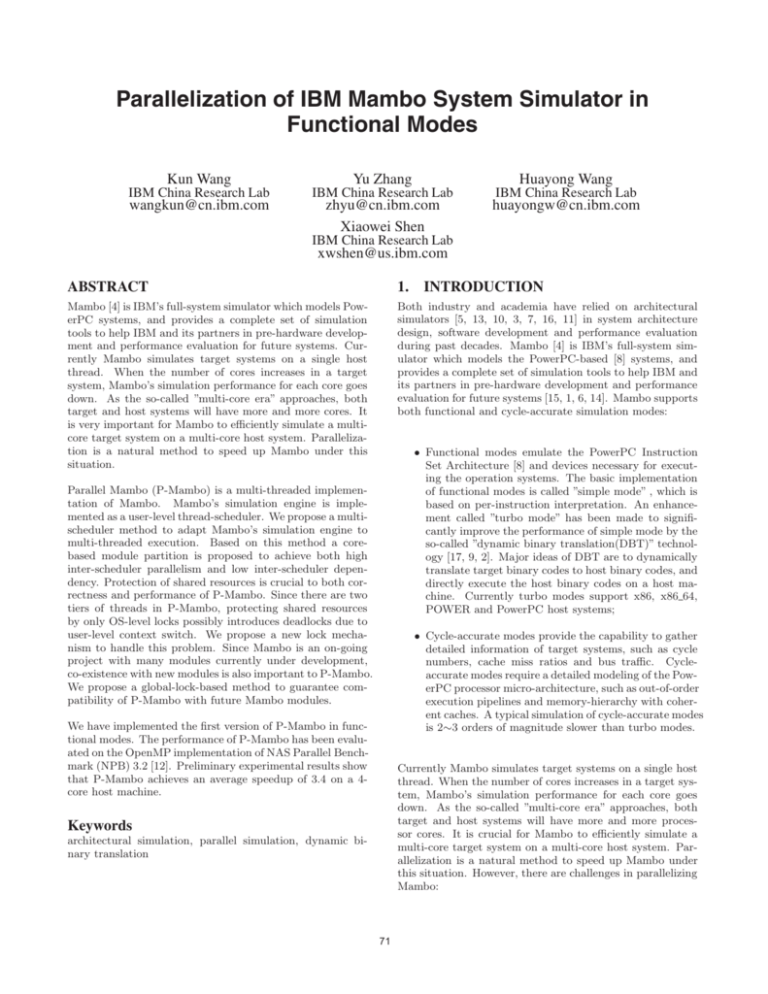Parallelization of IBM Mambo System Simulator in Functional Modes
advertisement

Parallelization of IBM Mambo System Simulator in
Functional Modes
Kun Wang
IBM China Research Lab
wangkun@cn.ibm.com
Yu Zhang
IBM China Research Lab
zhyu@cn.ibm.com
Xiaowei Shen
Huayong Wang
IBM China Research Lab
huayongw@cn.ibm.com
IBM China Research Lab
xwshen@us.ibm.com
ABSTRACT
1. INTRODUCTION
Mambo [4] is IBM’s full-system simulator which models PowerPC systems, and provides a complete set of simulation
tools to help IBM and its partners in pre-hardware development and performance evaluation for future systems. Currently Mambo simulates target systems on a single host
thread. When the number of cores increases in a target
system, Mambo’s simulation performance for each core goes
down. As the so-called ”multi-core era” approaches, both
target and host systems will have more and more cores. It
is very important for Mambo to efficiently simulate a multicore target system on a multi-core host system. Parallelization is a natural method to speed up Mambo under this
situation.
Both industry and academia have relied on architectural
simulators [5, 13, 10, 3, 7, 16, 11] in system architecture
design, software development and performance evaluation
during past decades. Mambo [4] is IBM’s full-system simulator which models the PowerPC-based [8] systems, and
provides a complete set of simulation tools to help IBM and
its partners in pre-hardware development and performance
evaluation for future systems [15, 1, 6, 14]. Mambo supports
both functional and cycle-accurate simulation modes:
• Functional modes emulate the PowerPC Instruction
Set Architecture [8] and devices necessary for executing the operation systems. The basic implementation
of functional modes is called ”simple mode” , which is
based on per-instruction interpretation. An enhancement called ”turbo mode” has been made to significantly improve the performance of simple mode by the
so-called ”dynamic binary translation(DBT)” technology [17, 9, 2]. Major ideas of DBT are to dynamically
translate target binary codes to host binary codes, and
directly execute the host binary codes on a host machine. Currently turbo modes support x86, x86 64,
POWER and PowerPC host systems;
Parallel Mambo (P-Mambo) is a multi-threaded implementation of Mambo. Mambo’s simulation engine is implemented as a user-level thread-scheduler. We propose a multischeduler method to adapt Mambo’s simulation engine to
multi-threaded execution. Based on this method a corebased module partition is proposed to achieve both high
inter-scheduler parallelism and low inter-scheduler dependency. Protection of shared resources is crucial to both correctness and performance of P-Mambo. Since there are two
tiers of threads in P-Mambo, protecting shared resources
by only OS-level locks possibly introduces deadlocks due to
user-level context switch. We propose a new lock mechanism to handle this problem. Since Mambo is an on-going
project with many modules currently under development,
co-existence with new modules is also important to P-Mambo.
We propose a global-lock-based method to guarantee compatibility of P-Mambo with future Mambo modules.
• Cycle-accurate modes provide the capability to gather
detailed information of target systems, such as cycle
numbers, cache miss ratios and bus traffic. Cycleaccurate modes require a detailed modeling of the PowerPC processor micro-architecture, such as out-of-order
execution pipelines and memory-hierarchy with coherent caches. A typical simulation of cycle-accurate modes
is 2∼3 orders of magnitude slower than turbo modes.
We have implemented the first version of P-Mambo in functional modes. The performance of P-Mambo has been evaluated on the OpenMP implementation of NAS Parallel Benchmark (NPB) 3.2 [12]. Preliminary experimental results show
that P-Mambo achieves an average speedup of 3.4 on a 4core host machine.
Currently Mambo simulates target systems on a single host
thread. When the number of cores increases in a target system, Mambo’s simulation performance for each core goes
down. As the so-called ”multi-core era” approaches, both
target and host systems will have more and more processor cores. It is crucial for Mambo to efficiently simulate a
multi-core target system on a multi-core host system. Parallelization is a natural method to speed up Mambo under
this situation. However, there are challenges in parallelizing
Mambo:
Keywords
architectural simulation, parallel simulation, dynamic binary translation
71
1. Protecting shared resources from concurrent accesses
is critical to parallelizing a sequential program. The
simulation engine of Mambo is a user-level threadscheduler. A Mambo module can be regarded as a
user-level thread. There are 2 tiers of threads in PMambo. One is OS-level, the other is user-level. Protection of share resources should be carefully designed
to avoid deadlocks and minimize overhead;
2. Parallelizing turbo modes of Mambo introduces some
unique challenges related to dynamic binary translation. For example, the PowerPC architecture supports
self-modifying codes, i.e. target binary codes are possibly generated on-the-fly. It is critical to both correctness and performance of P-Mambo to detect the modified codes and keep coherency of translation caches
among multiple host threads; and
Figure 1: Ready queue of a tsim
while (! core->stop)
{
Fetch_Instruction(&core, &inst);
Decode_Instruction(&core, &inst);
Execute_Instruction(&core, &inst);
Check_Interrupt_Exception(&core, &inst);
do_delay(inst->delay);
}
3. Mambo is an on-going project. Many teams are developing new modules for Mambo to support new target
processors and devices. Although the existing modules
can be modified to guarantee their correctness in parallel execution, a mechanism is needed to ensure that
P-Mambo can co-exist with new modules, which are
possibly not thread-safe in a parallel environment.
After invoking do_delay(inst->delay), the job is switched
out and re-activated inst->delay cycles later. By this way,
multiple cores can be simulated in an interleaving manner.
Tsim also provides primitives for inter-job synchronization.
For example, a producer job can wake up a consumer job by
a counter [4] when data becomes ready.
We have implemented the first version of P-Mambo in functional modes. Some benchmarks have been tested to evaluate its performance. The host machine is an IBM Blade
Center LS21, which has two dual-core AMD Opteron 275
processors and 8GB memory. The target machine is a 4core PowerPC machine with 6GB memory. The benchmark
set is the OpenMP implementation of NAS Parallel Benchmark (NPB) 3.2 [12]. The experimental results show that
the maximum and average speedups of P-Mambo are 3.8
and 3.4 respectively.
As a user-level thread-scheduler, tsim supports only one
active job at any time. Mambo is implemented as a sequential simulator because there is only one tsim to schedule Mambo’s modules. We have two choices to parallelize
Mambo:
The reminder of the paper is organized as follows. Section 2
presents our design and implementation of P-Mambo. Section 3 shows the experimental results of P-Mambo on NPB
benchmark set. Finally, Section 4 concludes the paper.
2.
1. creating multiple tsims, each of which runs on a dedicated host thread; and
2. enhancing tsim to support the execution of multiple
active jobs on multiple host threads.
DESIGN AND IMPLEMENTATION
In this section, we first present our design on simulation engine enhancement and module partion in P-Mambo. Then
we describe implementation details to attack challenges mentioned in section 1, which are shared resource protection,
co-existence with new modules and handling of DBT-related
issues in P-Mambo.
Both choices faces the same problem of what group of jobs
can be executed simultaneously. We prefer the first choice,
because the second introduces more complexity and overhead in protection of tsim internal data structure. There are
three challenges once we have multiple concurrent tsims:
2.1 Simulation Engine Enhancement
1. how to partition jobs among tsims to allow maximum
parallelism;
Mambo is a discrete event-driven simulator. A scheduler
(named tsim) sorts and schedules all modules (named jobs)
by their trigger time in Mambo. Figure 1 illustrates a job
queue of a tsim. To simplify the development effort while
still precisely modeling hardware events, tsim is implemented
as a user-level thread-scheduler [4]. Each job is regarded as
a user-level non-preemptive thread on tsim. Below is an
example job simulating a core.
2. how to support job interactions across tsims with minimum overhead; and
3. how to protect shared resources accessed by multiple
jobs with minimum overhead.
72
2.2 Job Partition
is user-level (intra tsim). Due to these two tiers of threads,
deadlocks in P-Mambo are different from that in traditional
multi-threaded programming. Competition for one type of
shared resource introduces no deadlock in traditional multithreaded programming, however may result in deadlocks in
P-Mambo.
Job partition determines parallelism and interaction between
different tsims, and thus is crucial to performance. We
choose core-based job partition due to following reasons: 1)
in functional modes, most workloads are from the simulation of processor cores; 2) there exists natural parallelism
between different cores; and 3) the data dependency between
different cores is low.
Here is an example of deadlock competing only one type
of shared resource in P-Mambo. Load Reserve (larx) and
Store Conditional (stcx) instructions are used in implementing atomic operations in the PowerPC architecture [8]. A
larx instruction creates a reservation for an address. A stcx
instruction successfully performs a store to the address only
if the reservation created by the previous larx is not cleared
by another processor or mechanism. Therefore, stcx instructions should be serialized to guarantee the correctness in
P-Mambo. Below is the code segment of handling stcx instructions using OS-level lock to guarantee thread-safety.
The general rules to create jobs on tsims are as follows:
1. jobs belonging to the same target processor should be
created on the same tsim;
2. jobs belonging to different target processors can be created on different tsims.
The number of tsims created can be customized in P-Mambo.
Users can create as many host threads as they want. By this
way, users can simulate a target machine with more processor cores than the host machine.
// handling Store Conditional instructions
stcx(Address addr, Value v)
{
os_level_lock(reservation(addr));
2.3 Job Interactions
There are two types of job interactions in tsim: 1) one job
wakes up another job; 2) one job blocks anther job. Both
of them are implemented by ready or waiting queue manipulations. Thread-safety should be guaranteed for inter-tsim
job interactions. One possible implementation is to simply
serialize accesses to shared queues by locks. However, there
is only one ready queue in a tsim. Each time a tsim switches
from one job to another, the ready queue is accessed. Obtaining and releasing lock for each ready queue access introduce too much overhead. We improve the implementation
by adding another ready queue named external ready queue
to tsim. A job is inserted into the external ready queue when
it is waken up by a job on another tsim. The ready queue
access in job switch is implemented as follows:
clearing_reservation(reservation(addr));
if (core->reservation_addr != addr)
{
os_level_unlock(reservation(addr));
return (RESERVATION_LOST);
}
else
write_memory_with_latency(addr, v);
os_level_unlock(reservation);
return (SUCCESS);
}
//Getting next ready job
if (tsim->external_readyq == NULL)
{
get_next_ready_job(tsim->internal_readyq);
}
else
{
lock(tsim->external_readyq);
get_next_ready_job(tsim->external_readyq);
unlock(tsim->external_readyq);
}
Consider a scenario of simulating four cores on two tsims.
There are core job 1 and 2 on tsim 1. Deadlock occurs if the
events happen in the following sequence:
• job 1 obtains lock for a reservation;
• job 1 is switched out by write_memory_with_latency;
• job 2 is switched in and tries to obtain lock for the
same reservation.
Since the external ready queue is empty in most cases, the
overhead of obtaining and releasing lock is low.
This case shows that accesses to shared resource with tsimlevel context switch can not be protected by OS-level locks.
We propose job-level lock to attack the problem. The major
idea is that failure in competing job-level lock results in only
hanging up current job, instead of blocking host thread of
current tsim. Below are the pseudo codes of obtaining and
releasing a job-level lock.
2.4 Shared Resource Protection
Protecting shared resources from concurrent accesses is critical to both correctness and performance of parallelizing a
sequential program. Lock is a common technique to serialize
all accesses to shared resources. However there are 2 tiers of
threads in P-Mambo. One is OS-level (inter tsim), the other
73
job_level_lock(job_lock* l)
{
os_level_lock(l->os_lock);
if (l->counter > 0) {
add_to_wait_queue(l->wait, current_job);
os_level_unlock(l->os_lock);
switch_to_next_ready_job();
}
else
l->counter = 1;
os_level_unlock(l->os_lock);
}
job_level_unlock(job_lock* l)
{
os_level_lock(l->os_lock);
Figure 2: Translation of a new target page
l->counter --;
wake_up_the_first_job(l->wait);
os_level_unlock(l->os_lock);
}
2.5 Co-existence with New Modules
Mambo is an on-going project. Many teams are developing
new modules to support new target processors and devices.
Although existing jobs can be modified to guarantee their
correctness in parallel execution, the new jobs are possibly
not thread-safe. It would be a disaster that P-Mambo is
broken each time a new job is introduced.
We use a tsim-level-lock to solve this problem. A tsim-levellock can be regarded as a global lock among all tsims. Once
it is obtained by a tsim, all other tsims should wait until it
is released. Furthermore, an attribute thread-safety is added
to all jobs. Each job is set as thread-unsafe by default. A
job can be set as thread-safe only if its thread-safety can be
guaranteed. And two new scheduling rules are also needed:
Figure 3: Handling of self-modifying codes and
translation cache flush
1. before switching to a thread-unsafe job, a tsim should
ask all others to wait by requiring a tsim-level lock;
and
1. adding a new cache item by translating a new target
page;
2. after leaving a thread-unsafe job, a tsim should wake
up all others by releasing the tsim-level lock.
2. flushing a cache item due to some reason, such as translation cache overflow; and
3. modifying a cache item due to self-modifying codes.
By the rules above, P-Mambo can ensure that no threadunsafe job intervenes with each other, i.e., execution of all
thread-unsafe jobs is serialized. Therefore, the correctness
can be guaranteed.
For the first case, it is impossible that when a tsim is going to translate a new page, some others are executing the
un-translated codes. Therefore, OS-level lock is enough to
handle this case. Figure 2 illustrates the basic idea to handle
the translation of a new target page in P-Mambo.
2.6 Handling of DBT Issues
Mambo turbo mode is based on dynamic binary translation.
It includes two major components: binary translator and
translation cache. Binary translator is responsible for generating host binary codes based on target codes, so it can be
shared by multiple tsims in nature. Translation cache contains the generated host codes for direct execution, and then
can not be shared by multiple tsims without any protection.
There are three cases that translation cache is modified:
For the second and third cases, it is possible that some other
tsims are executing the codes of a cache item when a tsim
wants to modify or invalidate it. A tsim can only modify or
invalidate a cache item when there is no other executing the
codes of the item. Figure 3 shows the steps to handle selfmodifying codes and translation cache flush in P-Mambo.
74
Figure 4: Speedups on 2 host threads
3.
Figure 5: Speedups on 4 host threads
PERFORMANCE EVALUATION
Parallel Benchmark (NPB) 3.2 shows promising speedups:
P-Mambo achieves the maximum and average speedups of
3.8 and 3.4 respectively, in the case of simulating a 4-core
PowerPC machine on a 4-core AMD Opteron machine.
We have implemented the first version of P-Mambo in functional modes. Some benchmarks have been tested to evaluate the performance of P-Mambo. The benchmark set is
the OpenMP implementation of NAS Parallel Benchmark
(NPB) 3.2 [12]. The host machine is an IBM Blade Center
LS21, which has two dual-core AMD Opteron 275 processors and 8GB memory. The target machine is a 4-core PowerPC machine with 6GB memory. The target OS is linux
2.6.16(ppc64), while the host OS is linux-2.6.18(x64 64).
Our next step is parallelizing Mambo in cycle-accurate modes.
It is much more difficult to parallelize cycle-accurate modes
than functional modes, because there are more dependencies existing in cycle-accurate modes than functional modes.
There are possibly two critical issues of parallelizing cycleaccurate Mambo: 1) how to efficiently exploit system-level
parallelism among different cores, as well as micro-architecturelevel parallelism among different core components; and 2)
how to achieve a reasonable trade-off between performance
and accuracy.
We evaluate the performance of P-Mambo under two cases:
one is creating two host threads, the other is creating four
host threads. Figure 4 summarizes the speedup of P-Mambo
in the case of creating two host threads. Please note that
”bt.A” means benchmark bt with size of Class A. Since
P-Mambo is a full-system simulator, the whole simulation
time of a benchmark includes overhead of booting OS. The
speedup with overhead is calculated by the whole simulation time of a benchmark, while the speedup without overhead is calculated by the pure workload simulation time of
a benchmark. The results show that P-Mambo achieves the
maximum and average speedups (without overhead) of 1.9
and 1.8 respectively when running on two host threads.
5. ACKNOWLEDGMENTS
We would like to thank Patrick Bohrer, Ahmed Gheith,
Ronald Rockhold, Lixin Zhang and James Peterson from
IBM Austin Research Laboratory for their help and support
on Mambo.
POWER and PowerPC are the trademarks of IBM Corp.
X86 is a trademark of Intel Corp. Opteron is a trademark
of Advanced Micro Devices, Inc. We acknowledge all trademarks referenced herein to be the property of their owners.
Figure 5 summarizes the speedup of P-Mambo in the case of
creating four host threads. P-Mambo shows its scalability
and achieves the maximum and average speedups (without
overhead) of 3.8 and 3.4 respectively when running on four
host threads.
4.
6. REFERENCES
[1] L. R. Bachega, J. R. Brunheroto, L. DeRose,
P. Mindlin, and J. E. Moreira. The BlueGene/L
Pseudo Cycle-accurate Simulator. In Proceedings of
the IEEE International Symposium on Performance
Analysis of Systems and Software (ISPASS), March
2004.
[2] F. Bellard. QEMU, a Fast and Portable Dynamic
Translator. USENIX 2005 Annual Technical
Conference, FREENIX Track, 2005.
[3] N. L. Binkert, R. G. Dreslinski, L. R. Hsu, K. T. Lim,
A. G. Saidi, and S. K. Reinhardt. Multifacet’s General
Execution-driven Multiprocessor Simulator (GEMS)
Toolset. Computer Architecture News (CAN),
September 2005.
[4] P. Bohrer, M. Elnozahy, A. Gheith, C. Lefurgy,
T. Nakra, J. Peterson, R. Rajamony, R. Rockhold,
CONCLUSIONS
Mambo is IBM’s full-system simulator which supports both
functional and cycle-accurate simulation modes, and hence
helps IBM and its partners in both pre-hardware development and performance evaluation for future systems. However, Mambo is a sequential program, its performance goes
down as the number of cores increases in a target system.
Thereby how to benefit from a multi-core host system in
simulating a multi-core target system is critical to Mambo,
when the so-called ”multi-core era” approaches. Parallelization is a natural way to speedup Mambo under this situation. We have implemented the first version of P-Mambo
in functional modes. The performance evaluation on NAS
75
[5]
[6]
[7]
[8]
[9]
[10]
H. Shafi, R. Simpson, E. Speight, K. Sudeep, E. V.
Hensbergen, and L. Zhang. Mambo – A Full System
Simulator for the PowerPC Architecture. ACM
SIGMETRICS Performance Evaluation Review,
31(4):8–12, March 2004.
D. Burger, T. M. Austin, and S. Bennett. Evaluating
Future Microprocessors: The SimpleScalar Tool Set.
Technical Report CS-TR-1996-1308, 1996.
L. Ceze, K. Strauss, G. Almasi, P. J. Bohrer, J. R.
Brunheroto, C. Cascaval, J. G. Castanos, D. Lieber,
X. Martorell, J. E. Moreira, A. Sanomiya, and
E. Schenfeld. Full Circle: Simulating Linux Clusters
on Linux Clusters. In Proceedings of the Fourth LCI
International Conference on Linux Clusters: The HPC
Revolution 2003, June 2003.
D. Chiou, D. Sunwoo, J. Kim, N. Patil, W. Reinhart,
E. Johnson, J. Keefe, and H. Angepat.
FPGA-Accelerated Simulation Technologies (FAST):
Fast, Full-System, Cycle-Accurate Simulators. In
Proceedings of the 40th Annual IEEE/ACM
International Symposium on Microarchitecture, 2007.
I. Corporation. The PowerPC Architecture: A
Specification for a New Family of Processors. Morgan
Kaufmann Publishers, Inc., 1994.
K. Ebcioglu and E. R. Altman. DAISY: Dynamic
Compilation for 100% Architectural Compatibility. In
Proceedings of 24th Annual International Symposium
on Computer Architecture, pages 26–37, 1997.
P. S. Magnusson, M. Christensson, J. Eskilson,
D. Forsgren, G. Hallberg, J. Hogberg, F. Larsson,
[11]
[12]
[13]
[14]
[15]
[16]
[17]
76
A. Moestedt, and B. Werner. Simics: A Full System
Simulation Platform. IEEE Computer, 35(2):50–58,
February 2002.
N. Njoroge, J. Casper, S. Wee, Y. Teslyar, D. Ge,
C. Kozyrakis, and K. Olukotun. ATLAS: A
Chip-Multiprocessor with Transactional Memory
Support. In Proceedings of the Conference on Design
Automation and Test in Europe (DATE), 2007.
NPB. NAS Parallel Benchmarks.
http://www.nas.nasa.gov/Resources/Software/npb.html.
M. Rosenblum, S. A. Herrod, E. Witchel, and
A. Gupta. Complete Computer System Simulation:
The SimOS Approach. IEEE parallel and distributed
technology: systems and applications, 3(4):34–43,
Winter 1995.
H. Shafi, P. J. Bohrer, J. Phelan, C. A. Rusu, and
J. L. Peterson. Design and validation of a performance
and power simulator for PowerPC systems. IBM
Journal of Research and Development,
47(5-6):641–651, September 2003.
T. B. Team. An Overview of the BlueGene/L
Supercomputer. In Proceedings of ACM/IEEE
Conference on Supercomputing, November 2002.
S. Wee, J. Casper, N. Njoroge, Y. Teslyar, D. Ge,
C. Kozyrakis, and K. Olukotun. A Practical
FPGA-based Framework for Novel CMP Research.
E. Witchel and M. Rosenblum. Embra: Fast and
Flexible Machine Simulation. In Proceedings of ACM
SIGMETRICS Conference on Measurement and
Modeling of Computer Systems, 1996.








